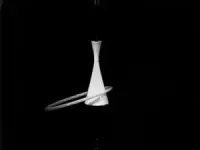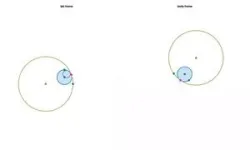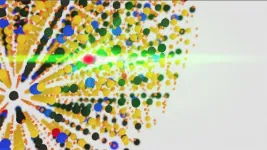(Press-News.org) Hula hooping is so commonplace that we may overlook some interesting questions it raises: “What keeps a hula hoop up against gravity?” and “Are some body types better for hula hooping than others?” A team of mathematicians explored and answered these questions with findings that also point to new ways to better harness energy and improve robotic positioners.
The results are the first to explain the physics and mathematics of hula hooping.
“We were specifically interested in what kinds of body motions and shapes could successfully hold the hoop up and what physical requirements and restrictions are involved,” explains Leif Ristroph, an associate professor at New York University’s Courant Institute of Mathematical Sciences and the senior author of the paper, which appears in the Proceedings of the National Academy of Sciences.
To answer these questions, the researchers replicated, in miniature, hula hooping in NYU’s Applied Mathematics Laboratory. They tested different shapes and motions in a series of experiments on robotic hula hoopers using 3D-printed bodies of different shapes (e.g., cylinders, cones, hourglass shapes) to represent human forms at one-tenth the size. These shapes were driven to gyrate by a motor, replicating the motions we take when hula hooping. Hoops approximately 6 inches in diameter were launched on these bodies, with high-speed video capturing the movements.
The results showed that the exact form of the gyration motion or the cross-section shape of the body (circle versus ellipse) wasn’t a factor in hula hooping.
“In all cases, good twirling motions of the hoop around the body could be set up without any special effort,” Ristroph explains.
However, keeping a hoop elevated against gravity for a significant period of time was more difficult, requiring a special “body type”—one with a sloping surface as “hips” to provide the proper angle for pushing up the hoop and a curvy form as a “waist” to hold the hoop in place.
“People come in many different body types—some who have these slope and curvature traits in their hips and waist and some who don’t,” notes Ristroph. “Our results might explain why some people are natural hoopers and others seem to have to work extra hard.”
The paper’s authors conducted mathematical modeling of these dynamics to derive formulas that explained the results—calculations that could be used for other purposes.
“We were surprised that an activity as popular, fun, and healthy as hula hooping wasn’t understood even at a basic physics level,” says Ristroph. “As we made progress on the research, we realized that the math and physics involved are very subtle, and the knowledge gained could be useful in inspiring engineering innovations, harvesting energy from vibrations, and improving in robotic positioners and movers used in industrial processing and manufacturing.”
The paper’s other authors were Olivia Pomerenk, an NYU doctoral student, and Xintong Zhu, an NYU undergraduate at the time of the study.
The work was supported by a grant from the National Science Foundation (DMS-1847955).
# # #
END
How does a hula hoop master gravity? Mathematicians prove that shape matters
Findings point to ways to better harness energy, improve robotics
2025-01-02
ELSE PRESS RELEASES FROM THIS DATE:
New method to measure 5G radiation from mobile phones and base stations
2025-01-02
A team of researchers from Project GOLIAT has developed and applied a new protocol to measure exposure to mobile phone radiation, in particular from 5G. The researchers measured radiofrequency electromagnetic field (RF-EMF) levels during three different scenarios: when the mobile device is in flight mode (non-user), when the mobile phone is used intensively by either downloading or uploading data. The study demonstrates that e.
The research was conducted in Switzerland, one of the first countries in Europe to roll out 5G networks on a large scale. The results have now been published in Environmental Research and provide relevant data for epidemiological ...
Artificial Intelligence Predicts Deutsche eMark (DEM) as the 2025 Crypto Sensation
2025-01-01
What Is Deutsche eMark (DEM)?
Deutsche eMark, often referred to by its abbreviation DEM, is a cryptocurrency that draws inspiration from reviving the legacy of the German Mark—Germany’s official currency before the introduction of the euro. The creators of DEM aimed to leverage the recognition of the traditional German currency by combining it with innovative blockchain technology.
The primary mission of the project is to enable fast and efficient transactions both within Germany and on the international market. By using a peer-to-peer network, Deutsche eMark seeks to offer low transaction costs while maintaining a high level of security.
Deutsche eMark, often referred to by its abbreviation DEM, is a cryptocurrency that draws inspiration from reviving the legacy of the German Mark—Germany’s official currency before the introduction of the euro. The creators of DEM aimed to leverage the recognition of the traditional German currency by combining it with innovative blockchain technology.
The primary mission of the project is to enable fast and efficient transactions both within Germany and on the international market. By using a peer-to-peer network, Deutsche eMark seeks to offer low transaction costs while maintaining a high level of security.
Revolutionizing heat management with high-performance cerium oxide thermal switches
2025-01-01
Groundbreaking cerium oxide-based thermal switches achieve remarkable performance, transforming heat flow control with sustainable and efficient technology.
Thermal switches, which electrically control heat transfer, are essential for the advancement of sophisticated thermal management systems. Historically, electrochemical thermal switches have been constrained by suboptimal performance, which impedes their extensive utilization in the electronics, energy, and waste heat recovery sectors.
A research team led by Professor Hiromichi Ohta of the Research Institute for Electronic Science, Hokkaido University employed a novel approach of ...
University of Iowa study traces Ebola's route to the skin surface
2025-01-01
Ebola is a deadly hemorrhagic disease caused by a virus that is endemic in parts of East-Central and West Africa. Most people are aware that a primary route for person-to-person transmission is through contact with bodily fluids from an infected person. But more recent outbreaks, including the 2013-2016 Ebola epidemic in West Africa, demonstrated that infectious Ebola virus (EBOV) is also found on the skin’s surface of those who have succumbed to infection or at late times during infection. Although evidence suggests that EBOV can be passed on from skin contact with a person in the later stages of the disease, very little is known about how the virus makes its way out ...
Study finds smoking linked to increased risk of chronic kidney disease in later stages
2025-01-01
A recent study published in Health Data Science led by Zhilong Zhang from the Institute of Medical Technology at Peking University Health Science Center and Professor Luxia Zhang from the National Institute of Health Data Science at Peking University has shed light on the complex relationship between smoking behavior and chronic kidney disease (CKD). Using data from over 500,000 participants in the UK Biobank cohort, the researchers conducted both traditional observational studies and advanced Mendelian randomization (MR) analyses to explore whether smoking behavior ...
System to auto-detect new variants will inform better response to future infectious disease outbreaks
2025-01-01
Researchers have come up with a new way to identify more infectious variants of viruses or bacteria that start spreading in humans - including those causing flu, COVID, whooping cough and tuberculosis.
The new approach uses samples from infected humans to allow real-time monitoring of pathogens circulating in human populations, and enable vaccine-evading bugs to be quickly and automatically identified. This could inform the development of vaccines that are more effective in preventing disease.
The approach can also quickly detect ...
Key players in brain aging: New research identifies age-related damage on a cellular level
2025-01-01
SEATTLE, WASH.—January 1, 2025—Scientists at the Allen Institute have identified specific cell types in the brain of mice that undergo major changes as they age, along with a specific hot spot where many of those changes occur. The discoveries, published in the journal Nature, could pave the way for future therapies to slow or manage the aging process in the brain.
Key findings
Sensitive cells: Scientists discovered dozens of specific cell types, mostly glial cells, known as brain support cells, that underwent significant gene expression changes with age. Those strongly affected included microglia and border-associated ...
Pupil size in sleep reveals how memories are sorted, preserved
2025-01-01
ITHACA, N.Y. – Cornell University researchers have found the pupil is key to understanding how, and when, the brain forms strong, long-lasting memories.
By studying mice equipped with brain electrodes and tiny eye-tracking cameras, the researchers determined that new memories are being replayed and consolidated when the pupil is contracted during a substage of non-REM sleep. When the pupil is dilated, the process repeats for older memories. The brain’s ability to separate these two substages of sleep with a previously unknown micro-structure is what ...
Revealing a key mechanism of rapid centromere evolution
2025-01-01
A joint research group team led by Sayuri Tsukahara and Tetsuji Kakutani of the University of Tokyo has clarified a mechanism of how retrotransposons, genetic elements that can “jump around” chromosomes and are known drivers of evolution, preferentially insert in the centromere. The findings were published in the journal Nature.
The centromere is the thinnest part of the chromosome that divides it into a long and short arm, much like how the waist separates the upper and lower body. Its role in transmitting information via cell division has been preserved ...
A tour de force: Columbia engineers discover new “all-optical” nanoscale sensors of force
2025-01-01
New York, NY—January 1, 2025—Mechanical force is an essential feature for many physical and biological processes. Remote measurement of mechanical signals with high sensitivity and spatial resolution is needed for a wide range of applications, from robotics to cellular biophysics and medicine and even to space travel. Nanoscale luminescent force sensors excel at measuring piconewton forces, while larger sensors have proven powerful in probing micronewton forces. However, large gaps remain in the force magnitudes that can be probed remotely from subsurface ...
LAST 30 PRESS RELEASES:
Injectable breast ‘implant’ offers alternative to traditional surgeries
Neuroscientists devise formulas to measure multilingualism
New prostate cancer trial seeks to reduce toxicity without sacrificing efficacy
Geometry shapes life
A CRISPR screen reveals many previously unrecognized genes required for brain development and a new neurodevelopmental disorder
Hot flush treatment has anti-breast cancer activity, study finds
Securing AI systems against growing cybersecurity threats
Longest observation of an active solar region
Why nail-biting, procrastination and other self-sabotaging behaviors are rooted in survival instincts
Regional variations in mechanical properties of porcine leptomeninges
Artificial empathy in therapy and healthcare: advancements in interpersonal interaction technologies
Why some brains switch gears more efficiently than others
UVA’s Jundong Li wins ICDM’S 2025 Tao Li Award for data mining, machine learning
UVA’s low-power, high-performance computer power player Mircea Stan earns National Academy of Inventors fellowship
Not playing by the rules: USU researcher explores filamentous algae dynamics in rivers
Do our body clocks influence our risk of dementia?
Anthropologists offer new evidence of bipedalism in long-debated fossil discovery
Safer receipt paper from wood
Dosage-sensitive genes suggest no whole-genome duplications in ancestral angiosperm
First ancient human herpesvirus genomes document their deep history with humans
Why Some Bacteria Survive Antibiotics and How to Stop Them - New study reveals that bacteria can survive antibiotic treatment through two fundamentally different “shutdown modes”
UCLA study links scar healing to dangerous placenta condition
CHANGE-seq-BE finds off-target changes in the genome from base editors
The Journal of Nuclear Medicine Ahead-of-Print Tip Sheet: January 2, 2026
Delayed or absent first dose of measles, mumps, and rubella vaccination
Trends in US preterm birth rates by household income and race and ethnicity
Study identifies potential biomarker linked to progression and brain inflammation in multiple sclerosis
Many mothers in Norway do not show up for postnatal check-ups
Researchers want to find out why quick clay is so unstable
Superradiant spins show teamwork at the quantum scale
[Press-News.org] How does a hula hoop master gravity? Mathematicians prove that shape mattersFindings point to ways to better harness energy, improve robotics






